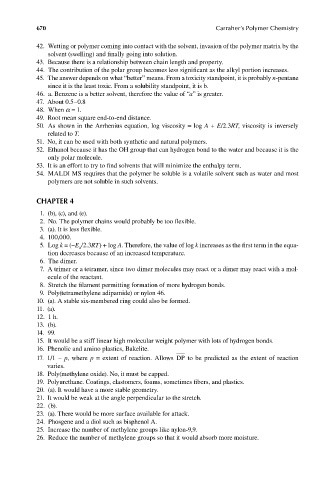Page 707 - Carrahers_Polymer_Chemistry,_Eighth_Edition
P. 707
670 Carraher’s Polymer Chemistry
42. Wetting or polymer coming into contact with the solvent, invasion of the polymer matrix by the
solvent (swelling) and finally going into solution.
43. Because there is a relationship between chain length and property.
44. The contribution of the polar group becomes less significant as the alkyl portion increases.
45. The answer depends on what “better” means. From a toxicity standpoint, it is probably n-pentane
since it is the least toxic. From a solubility standpoint, it is b.
46. a. Benzene is a better solvent, therefore the value of “a” is greater.
47. About 0.5–0.8
48. When α = 1.
49. Root mean square end-to-end distance.
50. As shown in the Arrhenius equation, log viscosity = log A + E/2.3RT, viscosity is inversely
related to T.
51. No, it can be used with both synthetic and natural polymers.
52. Ethanol because it has the OH group that can hydrogen bond to the water and because it is the
only polar molecule.
53. It is an effort to try to find solvents that will minimize the enthalpy term.
54. MALDI MS requires that the polymer be soluble is a volatile solvent such as water and most
polymers are not soluble in such solvents.
CHAPTER 4
1. (b), (c), and (e).
2. No. The polymer chains would probably be too fl exible.
3. (a). It is less fl exible.
4. 100,000.
5. Log k = (−E /2.3RT) + log A. Therefore, the value of log k increases as the first term in the equa-
a
tion decreases because of an increased temperature.
6. The dimer.
7. A trimer or a tetramer, since two dimer molecules may react or a dimer may react with a mol-
ecule of the reactant.
8. Stretch the filament permitting formation of more hydrogen bonds.
9. Poly(tetramethylene adipamide) or nylon 46.
10. (a). A stable six-membered ring could also be formed.
11. (a).
12. 1 h.
13. (b).
14. 99.
15. It would be a stiff linear high molecular weight polymer with lots of hydrogen bonds.
16. Phenolic and amino plastics, Bakelite.
17. 1/1 − p, where p = extent of reaction. Allows DP to be predicted as the extent of reaction
varies.
18. Poly(methylene oxide). No, it must be capped.
19. Polyurethane. Coatings, elastomers, foams, sometimes fibers, and plastics.
20. (a). It would have a more stable geometry.
21. It would be weak at the angle perpendicular to the stretch.
22. (b).
23. (a). There would be more surface available for attack.
24. Phosgene and a diol such as bisphenol A.
25. Increase the number of methylene groups like nylon-9,9.
26. Reduce the number of methylene groups so that it would absorb more moisture.
9/14/2010 3:44:14 PM
K10478.indb 670 9/14/2010 3:44:14 PM
K10478.indb 670

